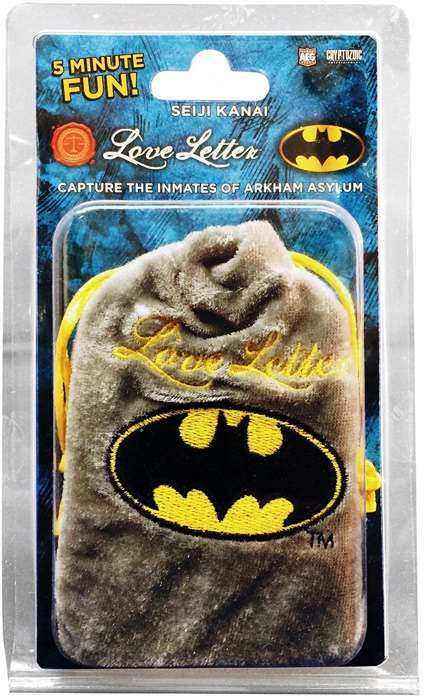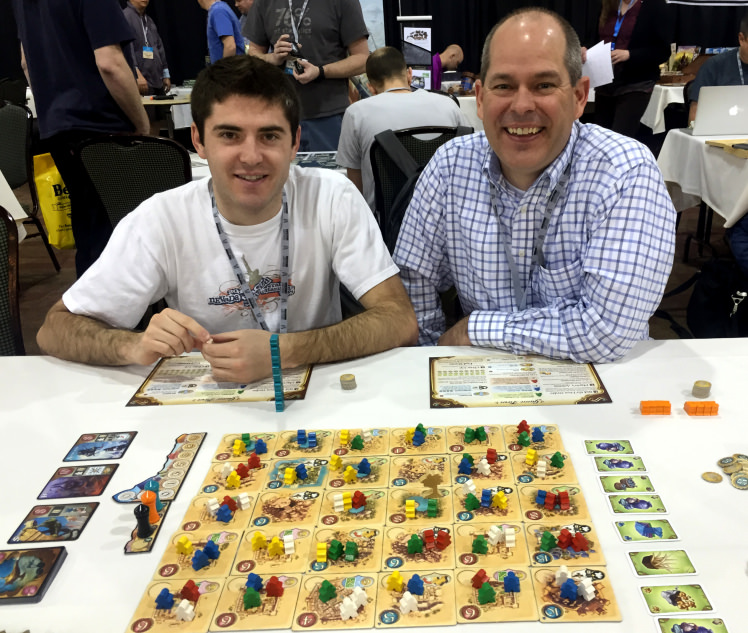Let’s head to Venice! Rialto board game review
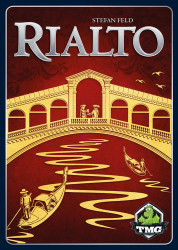
I love games that let me escape to different lands.
So when I heard about Rialto, a game set in Venice, Italy – a place I’d love to visit someday – I was curious to play it.
Check out the box artwork. Doesn’t it look like a cool game about riding gondolas through Venice?
Yet, when I opened the game, punched out the tokens, set it all up, and read the rules, I realized the game was less about the gondola on the box and more about the two guys doing business on the bridge.
You see, Rialto is a game where players jockey for position in a number of ways throughout the game – card set majority, spaces on the doge track, and councilmen in districts.
But seeing it out on the table, my kids turned up their noses at the game. It sure didn’t look very fun to them.
In fact, I had it set up on the table for a couple weeks before I could convince Caleb to play the game with me. And even at that, I had to make a deal with him to play.
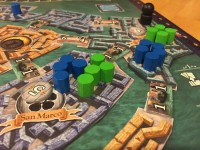
With all that effort to get in a first play, I was quite surprised when he immediately asked to play again. And the next day he asked to play again and again.
He doesn’t care about Venice or gondolas.
So why was Caleb so interested in playing again and again?
Because it’s a game that keeps him thinking and strategizing. The multitude of decisions and the way they all factor into the outcomes really caught his interest. And he wanted to feel that mental surge again and again.
There are a number of other reasons why the game turned out to be a hit. But first, I’ll give you a quick rundown on how the game plays.
How to play Rialto
In the board game Rialto, players are vying for control of 6 districts in Venice. In the process, players score victory points in a variety of ways. The player with the most victory points at the end of the game wins.
At the end of 6 rounds, players will get final victory points according to:
- Their rank within each District
- The total value of their Buildings
- Their remaining councilmen and money
They’ll add these final victory points to those they’ve already gained during play to see who wins the game.
Now you know what the goal is, let’s jump back to the beginning.
Set Up
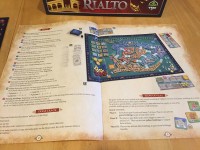
The rulebook does a great job showing how to set up the game. The opening page spread has a diagram with clear labels as to what goes where and who gets what. Just follow those instructions and you’re all set.
All the buildings will be set out by color (green, yellow, blue) and value (1, 2, 3, 4). The Gondola and Bridge tiles will be stacked in their piles. Every player will get a player board and 5 councilmen of their color to place on it. Then depending on the number of players, each player will get a set amount of coins. The rest of the coins and councilmen are put in the general supply.
Then players choose a starting building of value 1 to put on their player board.
Players also place one of their colored markers on the victory point track and the other on the Doge track. The Doge track markers will be stacked by beginning with the player to the right of the starting player and moving counter-clockwise.
The reason for this is that the markers on the Doge track will break all ties (which there will be plenty of). The markers further in the lead get the advantage. And if markers are on the same space, then the one on top has the advantage.
Shuffle the cards and you’re ready to play.
A Game Round
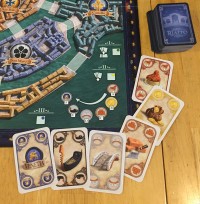
At first, the game may seem a bit overwhelming. There are 12 different building types, 7 different card types, 6 districts, 6 gondola tiles, and 6 bridge tiles of different value combinations.
But the game flows pretty smoothly through various phases and stages. And one of the great things about the Rialto game board is that the order of play is printed in the bottom-right corner. So if you need a quick reminder, just glance at the corner of the board.
A game round consists of 3 Phases:
- Get Cards
- Play Cards
- Activate Blue Buildings
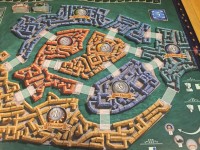
At the start of each round, the black District Marker is moved to the district next in numerical order. Each game the district tokens 1-6 are randomly placed on the 6 districts.
So the order in which players compete for control of different districts changes every game.
After the District Marker is moved to the district #1, round 1 begins.
1. GET CARDS
The uniqueness of Rialto is felt right from the start with the way the hands of cards are distributed. Rather than just dealing out 7 cards to each player, players take turns selecting a set of face-up cards.
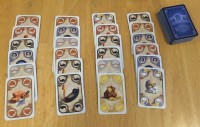
Cards are dealt out in columns of 6 cards. There will always be one more column set out than there are players.
Whoever is in the leading position on the Doge track will choose and takes one of the columns of cards. In addition, that player also draws 2 cards from the draw pile. Then the player in the second position on the Doge track takes one of the remaining columns of cards as well as 2 cards from the draw pile. And so on.
So now all players have a hand of 8 cards. They have also seen what types of cards the other players have chosen.
But no one has perfect knowledge of what the other players have because of the blind drawing of 2 cards.
Once everyone has their 8 cards, they must discard down to 7 cards before the next phase can take place.
You’ll notice right away that having only 7 cards in hand is very limiting for the next phase.
That’s where the Green buildings come into play.
Green buildings allow players to break the limits during this phase.
To activate a building (of any color or value), a player must spend 1 coin. They place 1 coin on the building they would like to activate to use its ability. Placing that coin helps remember that each building can only be activated once each round.
The Green buildings allow players to either draw more cards or keep more cards in their hand or do both – draw more and keep more.
2. PLAY CARDS
Once players have discarded down to their hand limit, it’s time to use the cards through 6 stages. In each stage, players may play cards of a specific type and add Jokers if desired. Each type of card corresponds to a different action.
The order in which the different types of cards are played is displayed on the game board for easy reference.
This table details the Stage (card type), which player plays their cards first in that stage, the Actions the cards give, and the Bonus that goes to the player who played the most of that type of card.
| Stage | First Player | Action | Bonus |
|---|---|---|---|
| 1. Doge | Leader on the Doge track goes first. | For each card played, the player advances one space on the Doge track. | Advance an additional space. |
| 2. Gold | Player who received Doge bonus goes first. | For each card played, collect 1 coin from the general supply. | Player gets 1 additional coin. |
| 3. Building | Player who received Gold bonus goes first. | Players may gain 1 building equal in value to (or lower than) the total number of Building cards played. | Player adds +1 to the number of cards played. |
| 4. Bridge | Player who received Building bonus goes first. | For each card played, the player gains 1 victory point (move ahead on the score track). Players who don’t play a Bridge card lose 1 point. | Player gets 1 additional victory point. AND places the next Bridge Tile on a free connection between two districts. |
| 5. Gondola | Player who received Bridge bonus goes first. | For each card played, the player moves 1 councilman from the general supply to their personal supply. | Player places a Gondola tile on a free connection between two districts. AND place 1 councilman from the general supply into one of those districts. |
| 6. Councilman | Player who received Gondola bonus goes first. | For each card played, the player moves 1 councilman from their personal supply to the current district. | Player places 1 additional councilman in the current district. |
Any time there’s a tie in the number of cards played, the position on the Doge track breaks the tie.
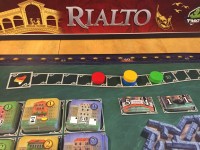
The remaining type of card is the Joker. As you’d expect, a Joker card can be played as any other type of card. However, to do so, it must be played in conjunction with another of that type of card. Meaning players can’t play a single Joker card on its own.
For example, to use a Joker as a Bridge card, the Joker card must be played with at least 1 real Bridge card.
Or a player can play 2 Joker cards as any 1 card of another type.
During this phase, players can also activate their Yellow buildings.
Yellow buildings grant a variety of special powers to help you swing the tide. For example, when activated with a coin, the value 3 yellow building acts like a Joker card. And the value 4 yellow building let’s you play 1 card as if it were 2 cards of another type. Cool stuff.
3. ACTIVATE BLUE BUILDINGS
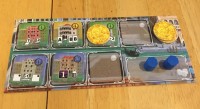
Once players have all taken turns playing cards in each of those 6 stages, it’s time to wrap up the round.
The last phase is quite simple. It’s the activation of Blue buildings.
Like activating buildings in prior rounds, players just need to place a coin on each blue building they would like to activate.
The blue buildings also grant a variety of powers depending on the value. The value 1 building lets a player upgrade one of their buildings. The value 2 building grants a victory point as well as letting the player move a councilman from the general supply to their personal supply. The value 3 building lets the player advance on the Doge track. And the value 4 blue building dishes out 3 victory points every time it’s activated.
Once all Blue buildings are activated, players move all the spent coins from their buildings back to the general supply and the next rounds begins.
End of Game & Scoring
After 6 rounds, the game ends and final scoring begins.
Score Districts:
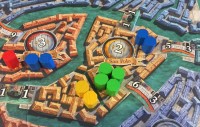
The player with the majority of councilmen in each district gets victory points equal to the value of the bridge and gondola tiles connected to that district. The player in second place for control gets half of that amount in victory points (rounded down). The player in third place gets victory points equal to half the value of the second place player’s victory points. And so on down the line.
For example, in District 2 of the photo to the right, the Green player has the majority with 4 councilmen and will get 13 victory points (6+5+1+1). Blue and Yellow both have 2 councilmen in the district. However, Yellow has the advantage on the Doge track. Thus Yellow is in second place and gets 6 victory points. And Blue gets 3 victory points for District 2.
Score Buildings:
Players receive victory points equal to the total value of their buildings.
Score Councilmen and Coins:
Players receive victory points equal to half of the total number of councilmen and coins remaining in their personal supply (rounded up).
Whoever has the most victory points at the end of final scoring is the winner.
What’s so great about Rialto?
Rialto isn’t a game full of laughter.
It’s a board game for thinking.
If you enjoy puzzling through moves and figuring out ways to maneuver things to your advantage, then Rialto is a game for you.
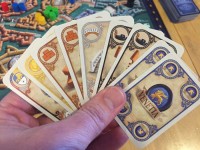
And for a guy that likes games that require strategy and interesting choices throughout, I’ll keep coming back to these Venetian districts.
To begin with, consider the card choices.
Unfortunately you have to discard some of the cards you’ve drawn. At the start of the game that most likely means you’ll discard down to 7 cards. Yet, there are 6 different cards and you’ll be dying to play cards in each stage every round.
But you just can’t do everything you’ll want to do. You’ll have to sacrifice some cards in order to play more of another type.
And what the other players do will impact your choices as well.
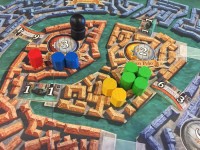
Victory Points are the name of the game. And players can score the most victory points by controlling districts on the board. But to control a district, players must get their councilmen into that district. Since the current district changes from round to round, there aren’t many opportunities to get councilmen into each district.
So you’ll want to play a bunch of Councilman cards.
But you can’t just play Councilman cards the whole time because you’ll run out of councilmen in your personal supply. So you’ll have to make sure to get councilmen from the general supply to your personal board in the first place.
And even though the Gondola tiles all just have a value of 1 on each end, when you place a Gondola tile you get to move a councilman directly from the general supply to a district that gondola touches. So it’s a great way to move a councilman into a district that has already been passed up in district order, or to add another councilman to a district you’re already in but need to increase your numbers to be the majority.
So you’ll want to play a bunch of Gondola cards.
Since the value of each district depends on the bridges and gondola tiles connected to it, you not only want to control districts, but you also want them to be worth something. So for that you’ll want to be the one placing the bridges so you can arrange them to your advantage.
So you’ll want to play a bunch of Bridge cards to get that bonus too.
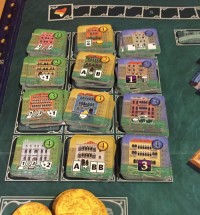
One of the things you’ll for sure want to do is increase your capabilities by having great buildings. Not only does the value of your buildings contribute to your score at the end of the game, but they also grant great powers during the game that help you along.
So you’ll want to play a bunch of Building cards to snag powerful buildings.
Oh, and you can’t forget Gold. Without Gold you won’t be able to activate any of your buildings that grant you special powers.
So you’ll want to play a bunch of Gold cards to keep your buildings in action.
And lest you think you can forget about Doge cards, if you’re behind on the Doge track you’re going to lose all ties. This includes ties between the number of cards played as well as the ties fighting for councilmen control in the districts.
So you’ll want to play a bunch of Doge cards to stay in the lead.
But there’s a hand limit so you can play everything you’ll want to!
Wow – there’s a lot to think about when choosing which cards to discard and which to play each round.
But that’s not all.
Even choosing which column of cards to choose each round is an interesting choice.
The other players will see which cards you’ve chosen, but you’ll also get at least 2 additional cards from the draw pile that they won’t know about. So you can do a bit of bluffing as to what you’ll play to keep them guessing.
Of course, on your end you’ll do a lot of guessing as well as to which cards and how many they’ll play as well.
Then there’s the choices of where to place bridge tiles and gondola tiles to set yourself up for valuable scoring while diminishing that of your opponents.
The unique district scoring at the end of the game is like icing on the cake for the player who manages to control a valuable district. They’ll get at least twice as many points as the player just beneath them. It’s a great way to separate yourself from the other players in points.
But since you can’t really control all the districts or place all the bridges and gondolas, you’ll have to find a way to work around what the other players place on the board.
Whew – there’s so much to think about and balance in the game.
That’s why Rialto has us wanting to play more.
How does Rialto score on our “Let’s Play Again” game meter?
The answer to this question depends on who you’re asking.
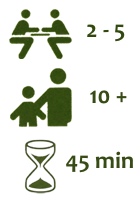 Those in our family that enjoy games requiring stringing actions together for control and points rate Rialto high on our “let’s play again” game meter.
Those in our family that enjoy games requiring stringing actions together for control and points rate Rialto high on our “let’s play again” game meter.
But others in our family don’t enjoy games with so many choices. They don’t want to maneuver the elements to gain small victories here and there in order to gain the major victory in the end. They still don’t have an interest in playing Rialto and thus come in at a zero on our scale.
Chances are, your family may be similar – comprised of family members that do and those that don’t like such strategy games.
But if you’ve got some family members or friends that like games that require strategic thinking, maneuvering, bluffing, and vying for control, then we suggest you give Rialto a go.
Thanks Tasty Minstrel Games for this strategic board game!

